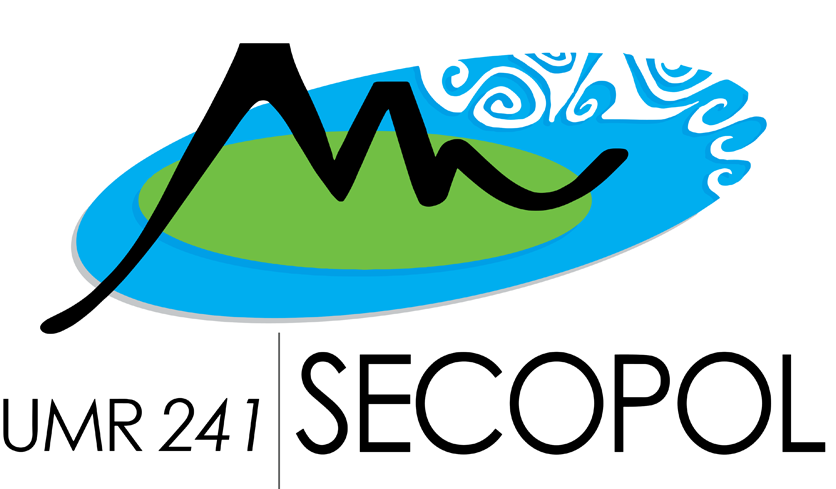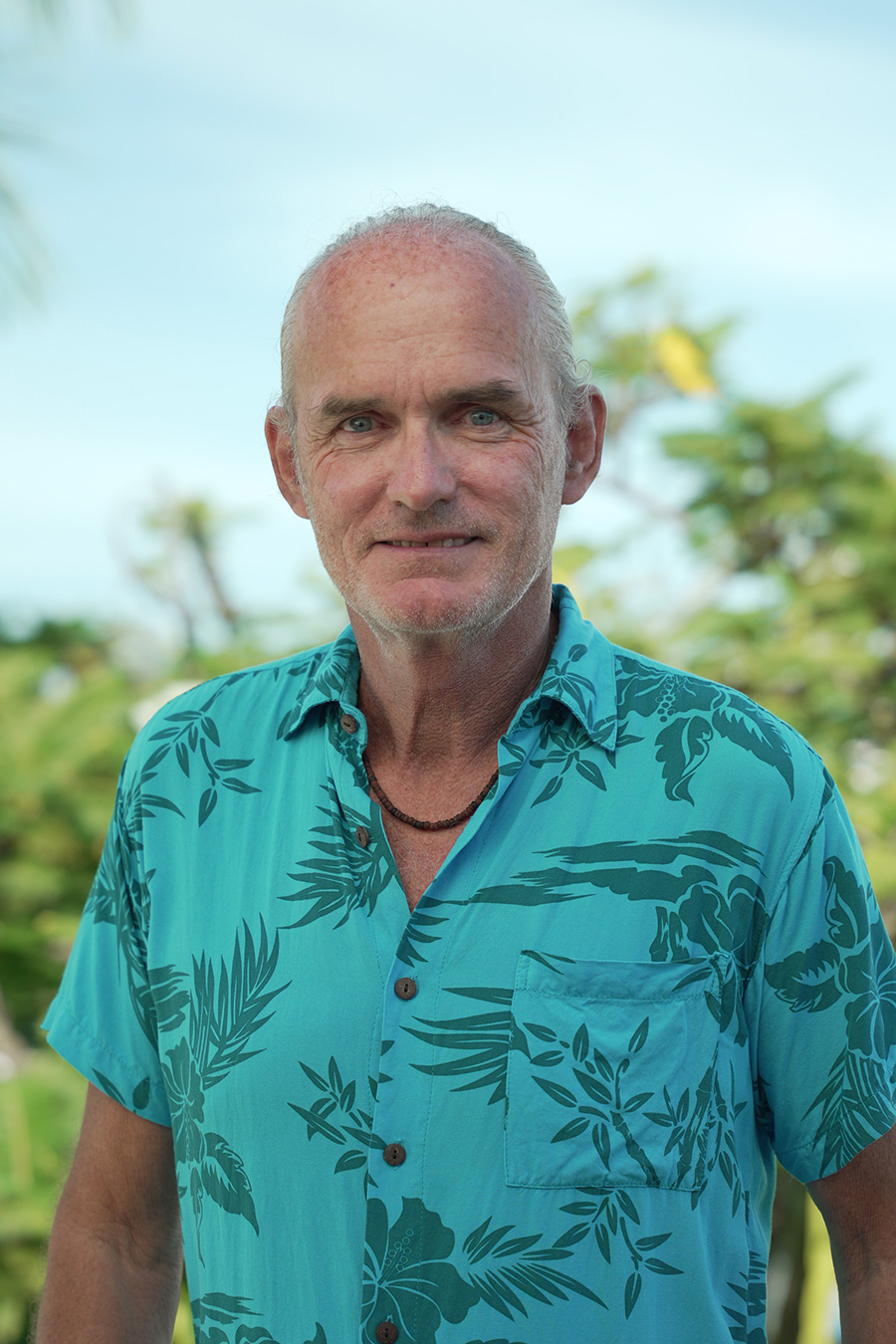Thématique(s) de Recherche :
Biologie et écologie végétale
Les actions de recherche en Polynésie française se focalisent sur l’adaptation des espèces endémiques et indigènes, la restauration de milieux dégradés, les effets interactifs des espèces envahissantes sur les écosystèmes.
Publications :
- https://orcid.org/0000-0003-3973-9868
- Archives HAL : https://www.archives-ouvertes.fr/search/index/?q=philippe-marmey&authIdPerson_i=1113371
- Toublanc-Lambault O, Pouteau R, Davezies M, Marron M, Pain A, Fogliani B, Marmey P. 2019. Environmental correlates for seed desiccation sensitivity of New Caledonian plant species. Pacific Science, 73:2.
- Villegente M, Marmey P, Job C, Galland M, Cueff G, Godin B, Rajjou L, Balliau T, Zivy M, Fogliani B, Sarramegna-Burtet V, and Job D. 2017. A combination of histological, physiological, and proteomic approaches shed light on seed desiccation tolerance of the basal angiosperm Amborella trichopoda. Proteomes 5(3), 19.
- Zongo C, Sabourin M, Demaret L, Gateble G, Fogliani B, Marmey P. 2016. Seed characterization for propagation and conservation of Oxera pulchella subsp. grandiflora (Dubard) de Kok, a new caledonian ornamental endemic. Journal of Propagation of Ornamental Plants 16, 4:137-145.
- Fourcade F, Pouteau R, Jaffre T, Marmey P. 2015. In situ observations of the basal angiosperm Amborella trichopoda reveal a long fruiting cycle overlapping two annual flowering periods. Journal of Plant Research 128:821-828.
- Sanier C, Sayegh-Alhamdia M, Jalloul A, Clerivet A, Nicole M, Marmey P. 2012. A 13-lipoxygenase is Expressed Early in the Hypersensitive Reaction of Cotton Plants to Xanthomonas campestris pv. malvacearum. Journal of Phytopathology 160:286-293.
- Champion A, Hebrard E, Parra B, Bournaud C, Marmey P, Tranchant C, Nicole M. 2009. Molecular diversity and gene expression of cotton ERF transcription factors reveal that group IXa members are responsive to jasmonate, ethylene and Xanthomonas. Molecular Plant Pathology 10:471-485.
- Marmey P, Cacas JL, Montillet JL, Sayegh-Alhamdia M, Jalloul A, Rojas-Mendoza A, Clerivet A, Nicole M. 2009. A novel patatin-like protein from cotton plant, GhPat1, is co-expressed with GhLox1 during Xanthomonas campestris-mediated hypersensitive cell death. Plant Cell Reports 28:155-164.
- Sayegh-Alhamdia M, Marmey P, Jalloul A, Champion A, Petitot AS, Clerivet A, Nicole M. 2008. Association of lipoxygenase response with resistance of various cotton genotypes to the bacterial blight disease. Journal of Phytopathology 156:542-549.
- Marmey P, Jalloul A, Alhamdia M, Assigbetse K, Cacas JL, Voloudakis AE, Champion A, Clerivet A, Montillet JL, Nicole M. 2007. The 9-lipoxygenase GhLOX1 gene is associated with the hypersensitive reaction of cotton Gossypium hirsutum to Xanthomonas campestris pv malvacearum. Plant Physiology and Biochemistry 45:596-606.
- Delannoy E, Marmey P, Jalloul A, Etienne H, Nicole M. 2006. Molecular biology of some cotton peroxydase genes. Journal of Cotton Science 10:53-60.
- Lecouls AC, Petitot AS, Marmey P, Silva MC, Guerra-Guimares L, Fernandez D, Nicole M. 2006. Physiology and defence mechanisms to pathogens in tropical woody plants. In: Franche C, editor. Molecular Biology of Tropical Plants. Kerala: Research Signpost Coll. p. 1-15.
- Voloudakis AE, Marmey P, Delannoy E, Jalloul A, Martinez C, Nicole M. 2006. Molecular cloning and characterization of Gossypium hirsutum superoxide dismutase genes during cotton-Xanthomonas campestris pv. malvacearum interaction. Physiological and Molecular Plant Pathology 68:119-127.
- Delannoy E, Lyon BR, Marmey P, Jalloul A, Daniel JF, Montillet JL, Essenberg M, Nicole M. 2005. Resistance of cotton towards Xanthomonas campestris pv. malvacearum. Annual Review of Phytopathology 43:63-82.
- Delannoy E, Marmey P, Penel C, Nicole M. 2004. The plant peroxidases of class III. Acta Botanica Gallica 151:353-380.
- Delannoy E, Jalloul A, Assigbetse K, Marmey P, Geiger JP, Lherminier J, Daniel JF, Martinez C, Nicole M. 2003. Activity of class III peroxidases in the defense of cotton to bacterial blight. Molecular Plant-Microbe Interactions 16:1030-1038.
- Jalloul A, Montillet JL, Assigbetse K, Agnel JP, Delannoy E, Triantaphylides C, Daniel JF, Marmey P, Geiger JP, Nicole M. 2002. Lipid peroxidation in cotton: Xanthomonas interactions and the role of lipoxygenases during the hypersensitive reaction. Plant Journal 32:1-12.
- Marmey P, Fauquet CM 2006. Cassava vein mosaic virus. Description of Plant Viruses, Annals of Applied Biology 435.
- Marmey P, Rojas-Mendoza A, de Kochko A, Beachy RN, Fauquet CM. 2005. Characterization of the protease domain of Rice tungro bacilliform virus responsible for the processing of the capsid protein from the polyprotein. Virology Journal, 2: 10.1186/1743-422X-2-33.
- Dai SH, Zheng P, Marmey P, Zhang SP, Tian WZ, Chen SY, Beachy RN, Fauquet C. 2001. Comparative analysis of transgenic rice plants obtained by Agrobacterium-mediated transformation and particle bombardment. Molecular Breeding 7:25-33.
- Marmey P, Bothner B, Jacquot E, de Kochko A, Ong CA, Yot P, Siuzdak G, Beachy RN, Fauquet CM. 1999. Rice tungro bacilliform virus open reading frame 3 encodes a single 37-kDa coat protein. Virology 253:319-326.
- Chen L, Marmey P, Taylor NJ, Brizard JP, Espinoza C, D’Cruz P, Huet H, Zhang S, de Kochko A, Beachy RN. 1998. Expression and inheritance of multiple transgenes in rice plants. Nature Biotechnology 16:1060-1064.
- Schöpke C, Taylor N, Carcamo R, Gonzalez de Schöpke AEK, N.K., Marmey P, Henshaw GG, Beachy RN, Fauquet CM. 1997. Stable transformation of cassava (Manihot esculenta Crantz) by particle bombardment and by Agrobacterium. African Journal of Root and Tuber Crops 2 (1&2).
- Qu RD, de Kochko A, Zhang LY, Marmey P, Li LC, Tian WZ, Zhang SP, Fauquet DM, Beachy RN. 1996. Analysis of a large number of independent transgenic rice plants produced by the biolistic method. In Vitro Cellular & Developmental Biology-Plant 32:233-240.
- Schopke C, Taylor N, Carcamo R, Konan NK, Marmey P, Henshaw GG, Beachy RN, Fauquet C. 1996. Regeneration of transgenic cassava plants (Manihot esculenta Crantz) from microbombarded embryogenic suspension cultures. Nature Biotechnology 14:731-735.
- Zhang SP, Chen LL, Qu RD, Marmey P, Beachy R, Fauquet C. 1996. Regeneration of fertile transgenic indica (group 1) rice plants following microprojectile transformation of embryogenic suspension culture cells. Plant Cell Reports 15:465-469.
- Nguyen HH, Zhang S, Chen L, Marmey P, Balasubramanian P, Nguyen VU, Beachy RN, Fauquet CM. 1995. The first successful results on rice transformation of the Vietnamese aromatic variety Nang Huong Cho Dao using particle gun. Vietnam Journal of Agriculture and Rural Development 8:292-293
- de Kochko A, Qu R, Marmey P, Rancé I, Fauquet CM, Beachy RN. 1994. Protein slot blotting: an easy, rapid and reliable technique to identify the expression of a protein in transgenic plants. Plant Molecular Biology Reporter 274-278.
- Mecencev N, Ghesquière A, Marmey P, Combes M-C, Guiderdoni E. 1997. Assessment of RAPD markers to detect genetic change in protoplast-derived rice plants. Journal of Genetics and Breeding 51:287-295.
- Ghesquiere A, Panaud O, Marmey P, Gavalda MC, Leblanc O, Grimanelli D. 1994. Analysis of Introgressions in Interspecific Crosses of Rice – Utilization of Molecular Markers. Genetics Selection Evolution 26:S67-S80.
- Marmey P, Beeching JR, Hamon S, Charrier A. 1994. Evaluation of Cassava (Manihot-Esculenta Crantz) Germplasm Collections Using Rapd Markers. Euphytica 74:203-209.
- Beeching JR, Marmey P, Gavalda MC, Noirot M, Haysom HR, Hughes MA, Charrier A. 1993. An Assessment of Genetic Diversity within a Collection of Cassava (Manihot-Esculenta Crantz) Germplasm Using Molecular Markers. Annals of Botany 72:515-520.
- Lashermes P, Cros J, Marmey P, Charrier A. 1993. Use of random amplified DNA markers to analyze genetic variability and relationships of Coffea species. Genetic Resources and Crop Evolution 40:91-99.
- Marmey P, Besse I, Verdeil JL. 1991. A Proteic Marker Found to Differentiate 2 Types of Calli of the Same Clones of Oil Palm (Eleais guineensis Jacq). Comptes Rendus De L Academie Des Sciences, Serie III 313:333-338.
- Dayde J, Ecochard R, Marmey P. 1989. The Possible Influence of Cytoplasm on the Performance of Reciprocal Soybean Hybrids. Euphytica 44:49-53
- Franklin-Tong VE, Ruuth E, Marmey P, Lawrence MJ, Franklin FCH. 1989. Characterization of a Stigmatic Component from Papaver rhoeas L Which Exhibits the Specific Activity of a Self-Incompatibility (S-) Gene-Product. New Phytologist 112:307-315
Biographie :
Durant les vingt premières années de ma carrière, mes activités de recherche étaient centrées sur des problématiques de plantes tropicales cultivées (manioc, riz, cotonnier) au travers de thématiques telles la diversité génétique, la virologie, les voies de signalisation, le développement d’outils biotechnologiques pour la résistance des plantes aux bioaggresseurs, et ce par l’utilisation de techniques de biologie moléculaire pour la génétique, la caractérisation de génome de virus et la compréhension des mécanismes de défense.
Depuis 2011, mes activités de recherche sont ancrées dans une thématique de biologie et écologie végétale centrée sur la flore endémique et indigène de l’Outre-Mer du Pacifique Sud. Mes recherches en Nouvelle-Calédonie se focalisaient sur l’écologie, la conservation et la valorisation de la biodiversité, avec un intérêt particulier pour la sensibilité à la dessiccation des graines tropicales. En Polynésie française depuis Septembre 2020, mes programmes de recherches contribue à l’émergence d’un axe nouveau au sein de l’UMR EIO, sur les espèces natives et invasives dans les écosystèmes insulaires terrestres.
Mes compétences incluent la conduite de programmes de recherche, la recherche de financements, la mise en place de partenariats, la formation à la recherche, la création et gestion de laboratoires.
Ma carrière s’est déroulée en Grande-Bretagne (2 années), aux Etats-Unis (61/2 années), en Nouvelle-Calédonie (41/2 années), en France métropolitaine, et depuis Septembre 2020 en Polynésie française.



